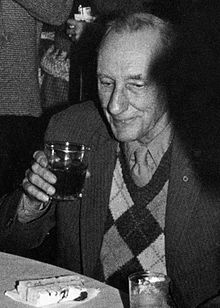William S. Burroughs | |
|---|---|
 Burroughs in 1983 | |
| Born | William Seward Burroughs II February 5, 1914 St. Louis, Missouri, U.S. |
| Died | August 2, 1997 (aged 83) Lawrence, Kansas, U.S. |
| Pen name | William Lee |
| Occupation | Author |
| Education | Harvard University (BA) |
| Genre | Beat literature, surrealism, satire |
| Literary movement | Beat Generation, postmodernism, science fiction |
| Notable works | Junkie (1953) Naked Lunch (1959) The Nova Trilogy (1961–1964) Cities of the Red Night (1981) The Place of Dead Roads (1983) |
| Spouse | Ilse Klapper (1937–1946)[1] Joan Vollmer (1946–1951) |
| Children | William S. Burroughs Jr. |
| Relatives | William Seward Burroughs I (grandfather) Ivy Lee (maternal uncle) |
| Signature | |
William Seward Burroughs II (/ˈbʌroʊz/; February 5, 1914 – August 2, 1997) was an American writer and visual artist. He is widely considered a primary figure of the Beat Generation and a major postmodern author who influenced popular culture and literature.[2][3][4] Burroughs wrote eighteen novels and novellas, six collections of short stories and four collections of essays, and five books have been published of his interviews and correspondences; he was initially briefly known by the pen name William Lee. He also collaborated on projects and recordings with numerous performers and musicians, made many appearances in films, and created and exhibited thousands of visual artworks, including his celebrated "shotgun art".[5]
Burroughs was born into a wealthy family in St. Louis, Missouri. He was a grandson of inventor William Seward Burroughs I, who founded the Burroughs Corporation, and a nephew of public relations manager Ivy Lee. Burroughs attended Harvard University, studied English, studied anthropology as a postgraduate, and attended medical school in Vienna. In 1942, Burroughs enlisted in the U.S. Army to serve during World War II. After being turned down by the Office of Strategic Services and the Navy, he developed a heroin addiction that affected him for the rest of his life, initially beginning with morphine. In 1943, while living in New York City, he befriended Allen Ginsberg and Jack Kerouac. Their mutual influence became the foundation of the Beat Generation, which was later a defining influence on the 1960s counterculture. Burroughs found success with his confessional first novel, Junkie (1953), but is perhaps best known for his third novel, Naked Lunch (1959). Naked Lunch became the subject of one of the last major literary censorship cases in the United States after its US publisher, Grove Press, was sued for violating a Massachusetts obscenity statute.
Burroughs killed his second wife, Joan Vollmer, in 1951 in Mexico City. Burroughs initially claimed that he shot Vollmer while drunkenly attempting a "William Tell" stunt.[6] He later told investigators that he had been showing his pistol to friends when it fell and hit the table, firing the bullet that killed Vollmer.[7] After Burroughs fled back to the United States, he was convicted of manslaughter in absentia and received a two-year suspended sentence.
While heavily experimental and featuring unreliable narrators, much of Burroughs's work is semiautobiographical, and was often drawn from his experiences as a heroin addict. He lived variously in Mexico City, London, Paris and the Tangier International Zone in Morocco, and traveled in the Amazon rainforest, with these locations featuring in many of his novels and stories. With Brion Gysin, Burroughs popularized the cut-up, an aleatory literary technique, featuring heavily in works such as The Nova Trilogy (1961–1964). Burroughs's work also features frequent mystical, occult, or otherwise magical themes, which were a constant preoccupation for Burroughs, both in fiction and in real life.[4][8]
In 1983, Burroughs was elected to the American Academy and Institute of Arts and Letters. In 1984, he was awarded the Ordre des Arts et des Lettres by France.[9] Jack Kerouac called Burroughs the "greatest satirical writer since Jonathan Swift";[10] he owed this reputation to his "lifelong subversion"[11] of the moral, political, and economic systems of modern American society, articulated in often darkly humorous sardonicism. J. G. Ballard considered Burroughs to be "the most important writer to emerge since the Second World War", while Norman Mailer declared him "the only American writer who may be conceivably possessed by genius".[10]
- ^ Cite error: The named reference
Lawlorwas invoked but never defined (see the help page). - ^ Severo, Richard (August 3, 1997). "William S. Burroughs Dies at 83; Member of the Beat Generation Wrote 'Naked Lunch'". The New York Times. Retrieved August 28, 2021.
- ^ Campbell, James (August 4, 1997). "Struggles with the Ugly Spirit". the Guardian. Retrieved August 28, 2021.
- ^ a b Stevens, Matthew Levi (2014). The Magical Universe of William S. Burroughs. Mandrake of Oxford.
- ^ Jones, Josh (September 14, 2012). "William S. Burroughs Shows You How to Make "Shotgun Art"". Open Culture. Retrieved March 9, 2021.
There is no exact process. If you want to do shotgun art, you take a piece of plywood, put a can of spray paint in front of it, and shoot it with a shotgun or high powered rifle.
- ^ El Nacional, September 8, 1951
- ^ La Prensa, September 8, 1951
- ^ Cite error: The named reference
Morgan-1988-2012was invoked but never defined (see the help page). - ^ Biography, The Guardian
- ^ a b Naked Lunch: The Restored Text, Harper Perennial Modern Classics (2005). It includes an introduction by J. G. Ballard and an appendix of biography and reference to further reading: "About the author", "About the book", and "Read on".
- ^ Burroughs, 2003. Penguin Modern Classics edition of Junky.